On a cold and overcast morning in mid-December we headed east – my wife and I – on I-10, past the towers of downtown Houston and industrial plants, and then south on the 610 east loop, over the ship channel bridge and then east again on Texas Independence Highway. We drove through the industrial landscape of Pasadena until we arrived at San Jacinto Battleground State Historic Site, located on a bend in the San Jacinto River by the Lynchburg Ferry landing site and the start of Buffalo Bayou and the Houston Ship Channel. The main feature in the park is a 570 foot limestone column topped with a star – representing the “lone star” of Texas – that marks the site where, in 1836, the Mexican general Santa Anna surrendered to Sam Houston, commander of the Texian army, which had been fighting for Texas’ independence from Mexico. After the defeat of the Mexican army, Texas became a republic and remained an independent country for 9 years until it joined the United States as the 28th state in 1845. As a direct result of the Texian victory at the San Jacinto battle site on April 21, which took place only a few weeks after the famous battle at The Alamo, Mexico eventually lost a huge swathe of territory that became absorbed into the United States as the states of California, New Mexico, Nevada, Arizona, Utah, and parts of Oklahoma, Kansas, Colorado and Wyoming. So this is obviously a key historical site for not only Texas but for the United States as a whole.
This was about the fourth time I had visited the San Jacinto Monument. My first time was back in 1989 or 1990, not long after I had moved to Texas from England in November 1989. As far as I could tell, the site had not changed at all during the 25 years or so since my first visit. So this latest visit was like stepping back in time, both for me personally, as well as in terms of the history of Texas. Construction of the monument was completed in 1939 and was built to mark the hundredth anniversary of Texas’ independence. The monument is of art deco style and was designed by an architect and engineer from Houston; Alfred C. Finn and Robert J. Cummins, respectively. The base of the monument includes a museum, with displays of historical artifacts from the period of the battle; including examples of the weapons and uniforms used by both sides during the War of Texas Independence. Photographs of some of these weapons can be viewed on the museum website. The exhibits include several Bowie knives, swords, rifles and muskets – including a well-preserved example of a British “Brown Bess” musket, which was used by Mexican soldiers during the war – paintings of some of the main actors in the battle, including Sam Houston and Santa Anna, original letters and various uniforms. The museum often holds special temporary exhibits, which change frequently, so visitors are likely to see something new each time they visit.
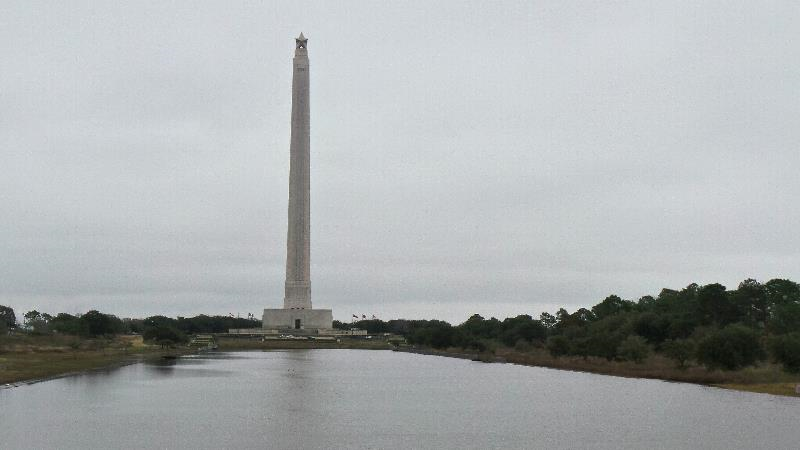
The San Jacinto battlefield monument from the reflecting pool. Copyright 2014, anothercappuccino.com.
We took the elevator to the observation floor, near the top of the monument column, to enjoy the views of the surrounding country. Even though the weather was rather poor during our visit, we still had quite clear views of the Houston Ship Channel; some of the industry that makes Houston one of the most important petroleum and chemical processing centers in the United States; and the Lynchburg Ferry site, which provides an alternative route to reach the monument from the I-10 highway on the east side of Houston. We had taken the ferry, which can be used free of charge, on our last visit to the site several years ago, when the weather was sunnier and warmer; this time we had opted to drive along the Texas Independence Highway instead. But the ferry provides a fun way to reach the monument and an alternative travel route to driving past the heavy industry that lines the ship channel.
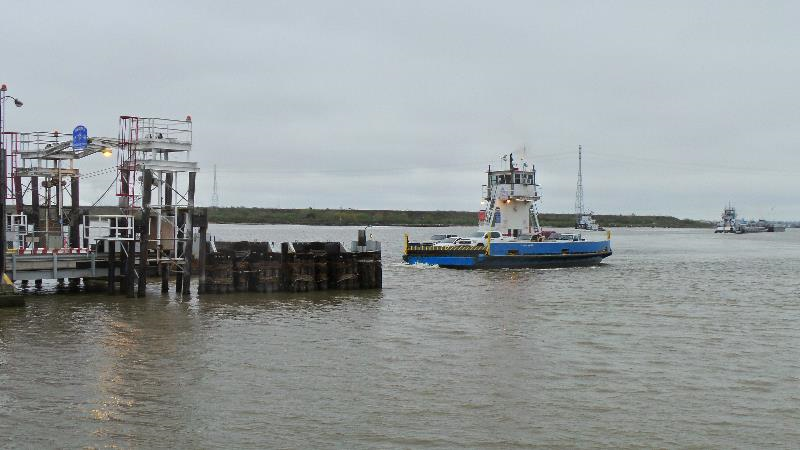
The Lynchburg Ferry. Ferry boats have been operated at this site since 1822. Copyright 2014, anothercappuccino.com.
On walking up the steps to the monument, we noticed the inscriptions that provide a written summary of the War of Texas Independence. One of the inscriptions that stood out for me was near the main entrance to the monument. It highlighted some of the places from where the soldiers in the Texian army originated, showing that early Texans came from all over the United States as well as many different countries, including England, Scotland, France and Germany among many others. The battle at San Jacinto was not an event that was important to American history alone. It was of international significance!
The Monument Inn Restaurant is located next to the Lynchburg Ferry landing site, which is just outside the San Jacinto battle site park. We ate lunch at the restaurant after we had finished our visit to the monument. It was the first time I had eaten at this restaurant and I was surprised to find how nice it was. I was surprised because it seemed to be a very isolated place and so we weren’t expecting much. I had asked the girl operating the elevator to the observation floor in the monument whether there was a café nearby and she had recommended the Monument Inn Restaurant. It turned out to be a very pleasant place and the seafood was fresh and tasty. I had grilled red snapper and my wife had the crawfish etouffee. We ate our meals while enjoying the views across San Jacinto River and watching some of the long barges traveling to and from the nearby ship channel.

The location of the Lynchburg Ferry, as seen from the observation floor at the top of the San Jacinto battlefield monument. The Monument Inn Restaurant building is at the center left of the picture, and part of the park boundary is shown in the foreground. Copyright 2014, anothercappuccino.com.
The site of the San Jacinto battle has been well preserved since the Texian and Mexican armies camped on opposite ends of what is now a park. On the day of the battle, the Texian army had been camped near the area where the World War I era battleship – the USS Texas – is now berthed; while the Mexican army was camped in the area on the other side of the monument, close to what is a hiking trail today. The battlefield site has been maintained mostly in its natural state, with oak trees, grassland and marshes (where alligators live). There is a fairly extensive series of hiking trails throughout the site, which I would have liked to have walked, but the weather was not so good on the day of our visit. We decided to save the hiking for our next visit!
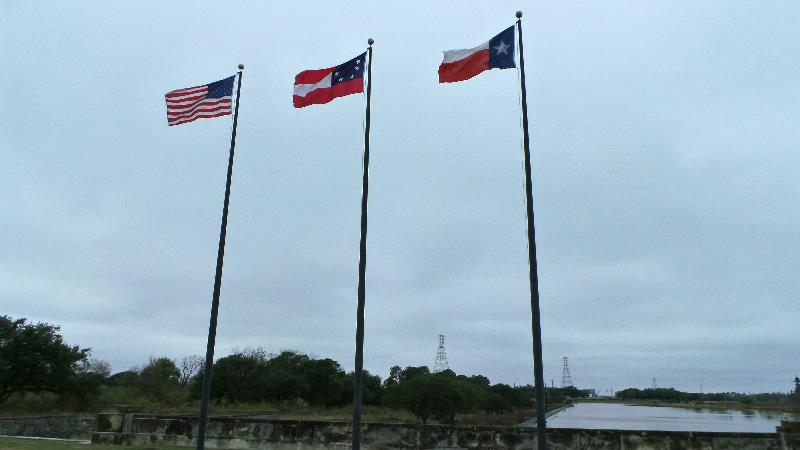
Three flags flying at the San Jacinto battlefield monument: The flag of the United States; the 1861-1865 Texas Confederacy States flag; and the current Texas state flag. Copyright 2014, anothercappuccino.com.
The park and museum are open from 9 a.m. till 6 p.m. The museum has an excellent website at http://www.sanjacinto-museum.org/, which includes detailed information about the history of both the battle and the monument.

A view of the San Jacinto battlefield monument from the shore of San Jacinto River, next to the Monument Inn Restaurant. Copyright 2014, anothercappuccino.com.
Interesting historical note: Texian Army or Texan Army? “Texian” was the name used during the early history of Texas to refer to non-Hispanic white residents of Mexican Texas and then independent Texas. Later, after Texas became a state within the United States, “Texan” became the common term to use to describe someone from Texas.
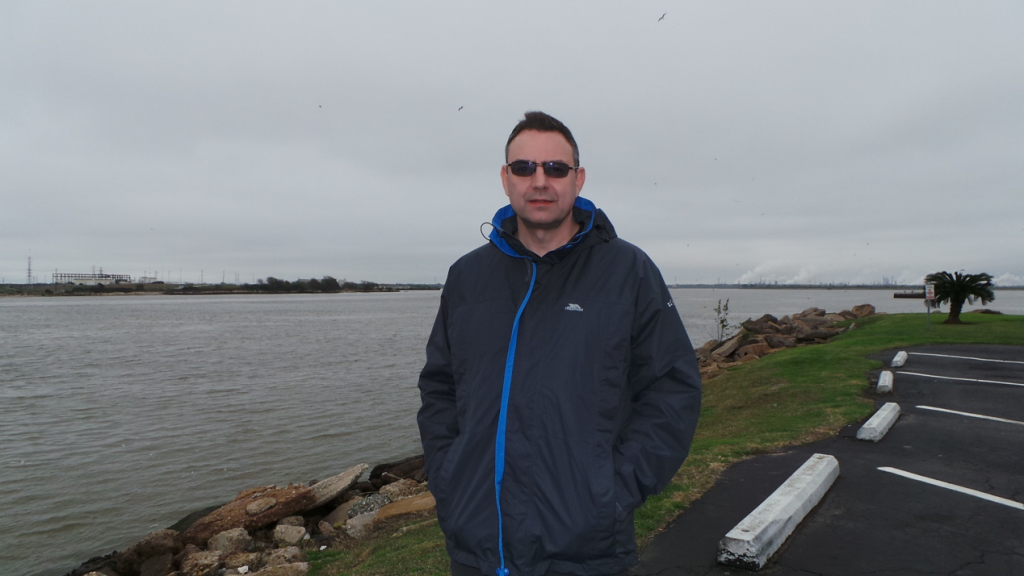
The author in the parking lot of the Monument Inn Restaurant, near the Lynchburg Ferry landing site. Copyright 2014, anothercappuccino.com.
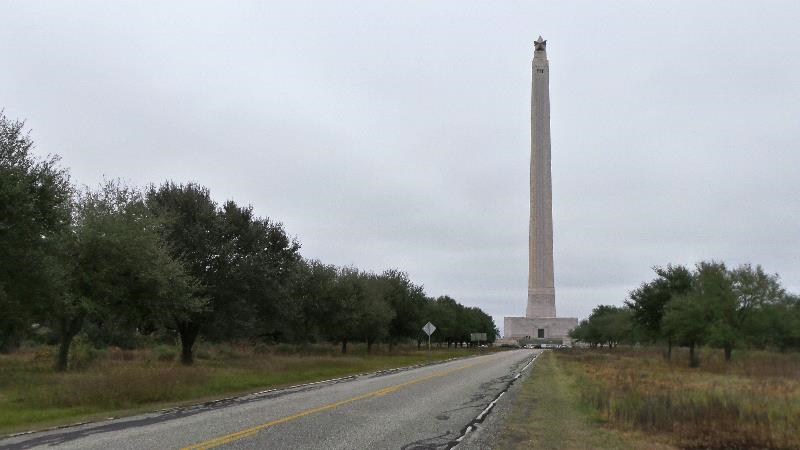
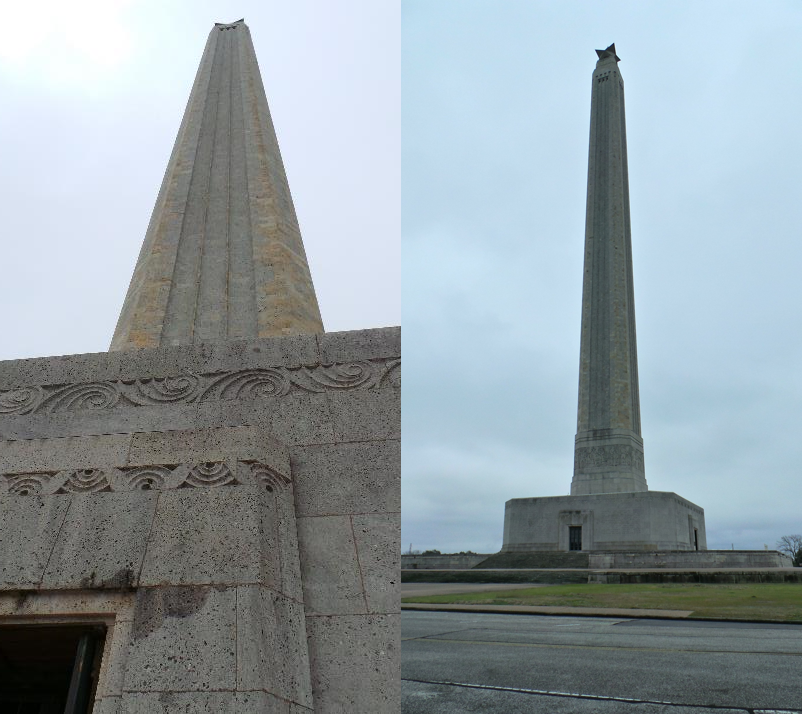
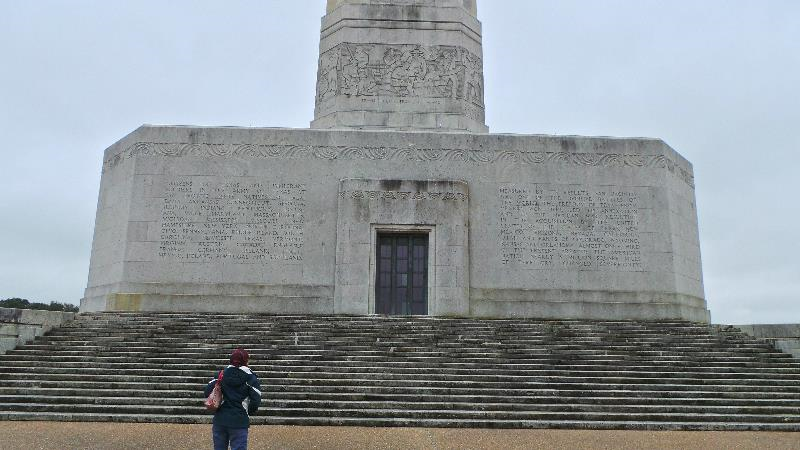
No comments yet.